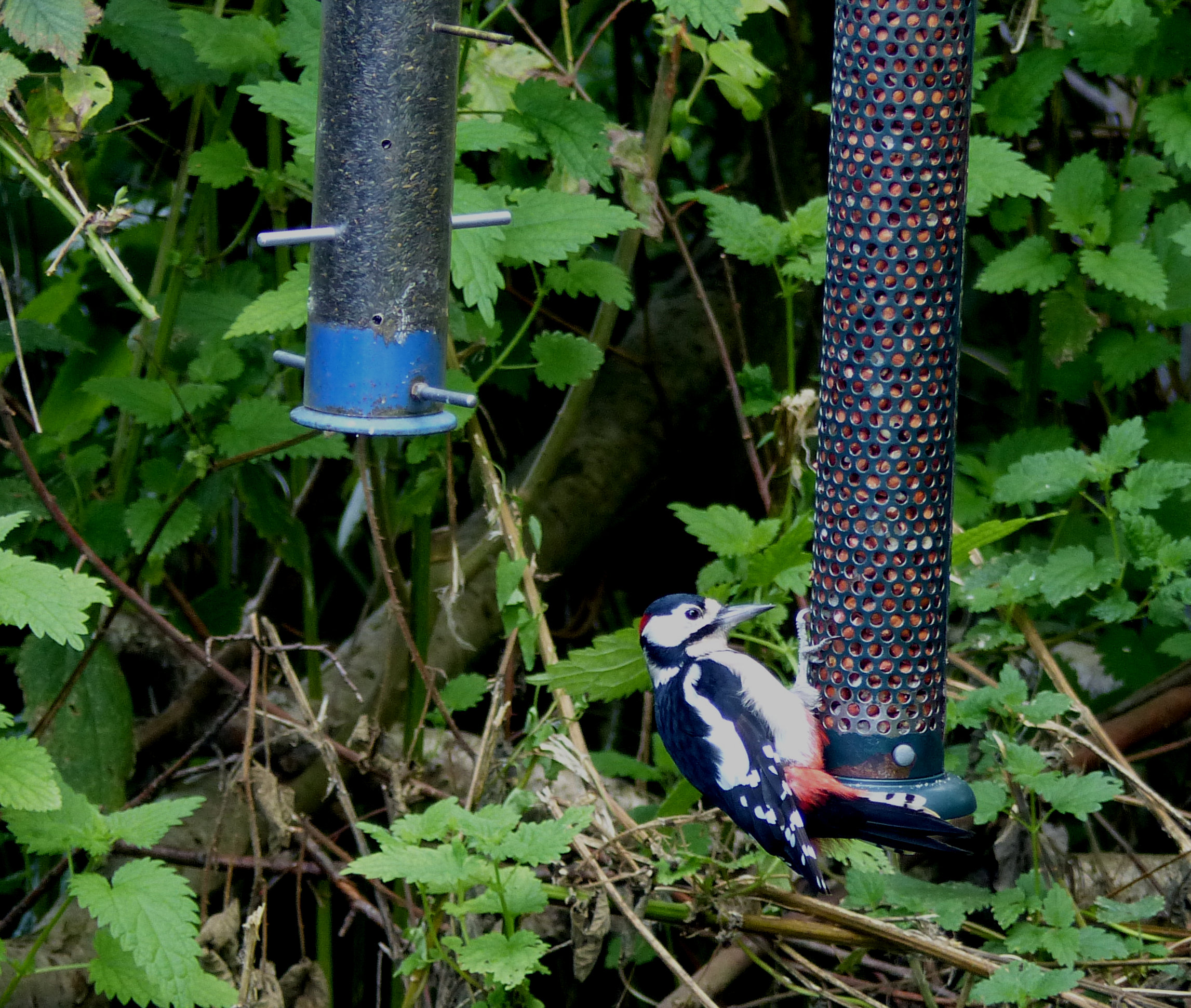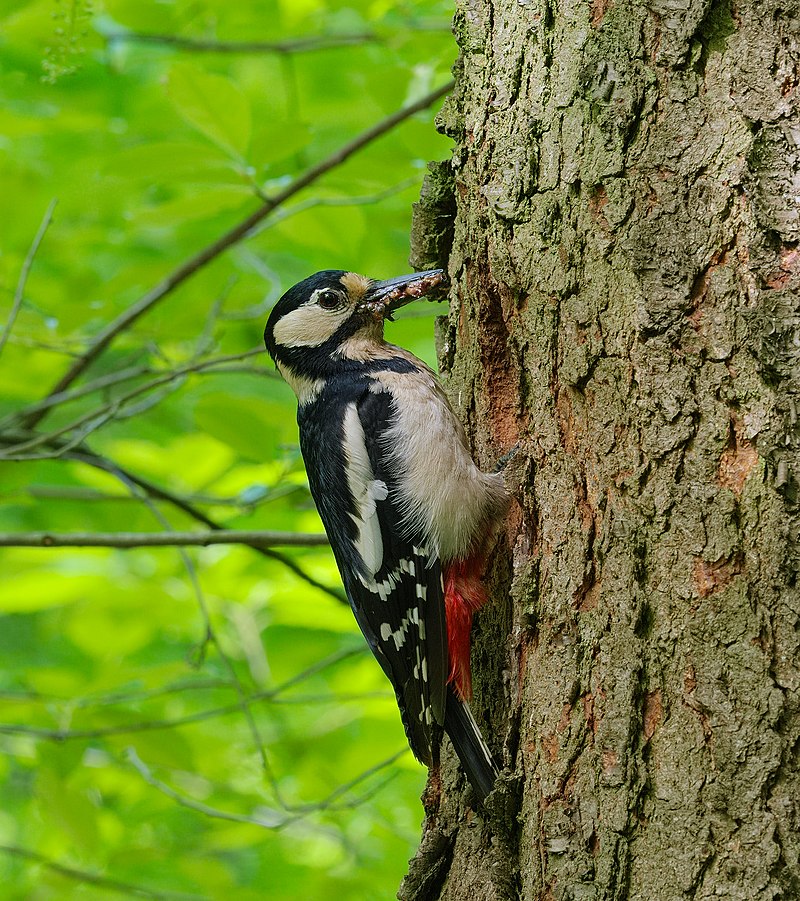Garden Wildlife
Garden Wildlife


What do they sound like?
There are two sorts of sound to listen for. One is the characteristic drumming by both sexes in springtime, as they beat their bills on tree trunks and other resonant surfaces. This is a territorial announcement and contact sounds. Each bout of drumming lasts less than a second. Here are two examples – note how the surface chosen for drumming changes the quality of the sound, but the pattern and duration is essentially the same in each case. Great Spotted Woodpeckers also have very distinctive calls and if you are walking in leafy woodlands in the summer these are often the only way you’ll know there is a woodpecker about.
Drumming Drumming Call
Great spotted woodpecker Dendrocopos major
This is the woodpecker species most likely to visit your garden, and it is recorded in about 28% of gardens nationally, making it currently the 19th commonest garden bird.


.jpg)
.jpg)
Male bird with red nape Female bird with black nape
What do they look like?
This is an unmistakable species, with striking black, white and red markings and large size (22cm) compared with many garden birds – it is about as big as a blackbird. (In Europe there are similar species with which it might be confused, but these do not occur in the Britain and Ireland). They have a black forehead and crown, with a red patch on the nape of the male (the female’s nape is black). The cheeks are white, highlighting the dark eye. There is a black stripe running from the base of the bill and joining a black stripe up the side of the neck. The throat is white, running down to the white breast. The bill is pointed, stout and powerful looking.
There is a white patch at the back of the neck, and white patches on the wings, with white stripes near the tips, all on a black background. The breast, belly and ventral region is white, but under the tail is red.
The legs are grey and strong, supporting the bird on vertical surfaces like tree trunks and feeders, with the stout black and white striped tail acting as a prop. See our tree-dwellers page for comparison photos.
Juveniles differ from the adults in that they have a red forehead but lack the prominent under-tail red patch
Where do they breed?
They use their powerful beaks to dig out nesting holes in rotting wood, where between April and June they produce a single annual brood of up to six eggs. Nest boxes for woodpeckers are commercially available, being a soft log with a pilot hole drilled so the birds can excavate their own nesting cavity. Another approach is to fill a conventional nest box with a block of soft balsa wood or tightly packed wood chips. These will only really be worth trying if your garden is has lots of trees.
What do they do?
Great spotted woodpeckers have a very visible impact on their habitat. Old trees and rotten wood may be riddled with smaller holes drilled during their feeding, and larger holes excavated for nesting. These are really important for other birds as well: for example I’ve seen what was a great spotted woodpecker nest in one year become the nest site for tree sparrows in subsequent years. They may destroy wooden feeders.
It’s usually quite easy to see these birds if they are around. They have a very distinctive swooping flight when covering distance between trees, and their calls and other sounds soon alert you to their presence.
In Britain the great spotted woodpecker is present all year round, while they are only sporadic in eastern Ireland. In some years large numbers may cross from northern Europe in winter.
How are they doing?
The BTO Breeding Birds Survey 2019 shows that great spotted woodpeckers are doing a bit better than holding their own, with an upward trend over the last 20 years, and an estimated 140,000 territories. They also seem to be more common in gardens nowadays.
Finding out more:
BTO profile on great spotted woodpecker
RSPB profile on great spotted woodpecker
Page written by Roy Smith, compiled by Steve Head
Bernard Collet, XC651763. Accessible at www.xeno-canto.org/651763.
Hannu Varkki, XC651780. Accessible at www.xeno-canto.org/651780
Stanislas Wroza, XC640108. Accessible at www.xeno-canto.org/640108.
What do they eat?
Great spotted woodpeckers are mainly insectivorous, feeding on the invertebrates that live in wood. Their habit of pecking hard at tree trunks and stumps makes a distinctive ticking sound which can alert you to their presence. You can hear the sound in this recording, between the calls:
Jordi Calvet, XC608683. Accessible at www.xeno-canto.org/608683
They are adept at using feeding stations in gardens, hanging onto upright feeders as if they were tree trunks and extracting sunflower hearts and peanut fragments with their long tongues. They will go for fruit and berries in autumn, and are not above raiding the nests of smaller birds for hatchlings.
Where do they breed?
They use their powerful beaks to dig out nesting holes in rotting wood, where between April and June they produce a single annual brood of up to six eggs. Nest boxes for woodpeckers are commercially available, being a soft log with a pilot hole drilled so the birds can excavate their own nesting cavity. Another approach is to fill a conventional nest box with a block of soft balsa wood or tightly packed wood chips. These will only really be worth trying if your garden is has lots of trees.
What do they do?
Great spotted woodpeckers have a very visible impact on their habitat. Old trees and rotten wood may be riddled with smaller holes drilled during their feeding, and larger holes excavated for nesting. These are really important for other birds as well: for example I’ve seen what was a great spotted woodpecker nest in one year become the nest site for tree sparrows in subsequent years. They may destroy wooden feeders.
It’s usually quite easy to see these birds if they are around. They have a very distinctive swooping flight when covering distance between trees, and their calls and other sounds soon alert you to their presence.
In Britain the great spotted woodpecker is present all year round, while they are only sporadic in eastern Ireland. In some years large numbers may cross from northern Europe in winter.
How are they doing?
The BTO Breeding Birds Survey 2019 shows that great spotted woodpeckers are doing a bit better than holding their own, with an upward trend over the last 20 years, and an estimated 140,000 territories. They also seem to be more common in gardens nowadays.
Finding out more:
BTO profile on great spotted woodpecker
Page written by Roy Smith, compiled by Steve Head
They are adept at using feeding stations in gardens, hanging onto upright feeders as if they were tree trunks and extracting sunflower hearts and peanut fragments with their long tongues. They will go for fruit and berries in autumn, and are not above raiding the nests of smaller birds for hatchlings.

What do they eat?
Great spotted woodpeckers are mainly insectivorous, feeding on the invertebrates that live in wood. Their habit of pecking hard at tree trunks and stumps makes a distinctive ticking sound which can alert you to their presence. You can hear the sound in this recording, between the calls:
What do they sound like?
There are two sorts of sound to listen for. One is the characteristic drumming by both sexes in springtime, as they beat their bills on tree trunks and other resonant surfaces. This is a territorial announcement and contact sounds. Each bout of drumming lasts less than a second. Here are two examples – note how the surface chosen for drumming changes the quality of the sound, but the pattern and duration is essentially the same in each case. Great Spotted Woodpeckers also have very distinctive calls and if you are walking in leafy woodlands in the summer these are often the only way you’ll know there is a woodpecker about.
Drumming Drumming Call
.jpg)
Juveniles differ from the adults in that they have a red forehead but lack the prominent under-tail red patch
Male bird with red nape Female bird with black nape
What do they look like?
This is an unmistakable species, with striking black, white and red markings and large size (22cm) compared with many garden birds – it is about as big as a blackbird. (In Europe there are similar species with which it might be confused, but these do not occur in the Britain and Ireland). They have a black forehead and crown, with a red patch on the nape of the male (the female’s nape is black). The cheeks are white, highlighting the dark eye. There is a black stripe running from the base of the bill and joining a black stripe up the side of the neck. The throat is white, running down to the white breast. The bill is pointed, stout and powerful looking.
There is a white patch at the back of the neck, and white patches on the wings, with white stripes near the tips, all on a black background. The breast, belly and ventral region is white, but under the tail is red.
The legs are grey and strong, supporting the bird on vertical surfaces like tree trunks and feeders, with the stout black and white striped tail acting as a prop. See our tree-dwellers page for comparison photos.
.jpg)

Great spotted woodpecker Dendrocopos major
This is the woodpecker species most likely to visit your garden, and it is recorded in about 28% of gardens nationally, making it currently the 19th commonest garden bird.
























